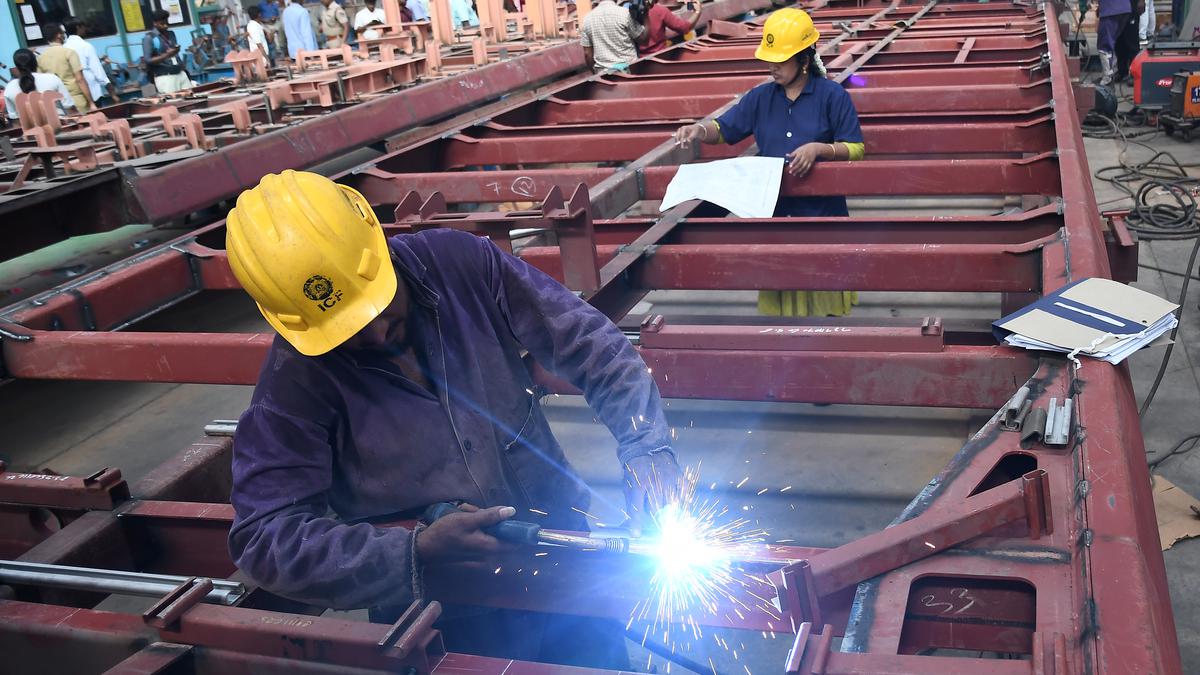Table of Contents
The Slowdown in India’s Manufacturing Sector

Image for representational purposes only | Photo Credit: B. Velankanni Raj
Significance
The slowdown in India’s manufacturing sector, as indicated by the S&P Global India Manufacturing Purchasing Managers’ Index (PMI), holds critical importance for the country’s economy. The manufacturing sector not only contributes significantly to India’s GDP but also plays a vital role in employment generation and export earnings.
Features
The S&P Global India Manufacturing PMI for October recorded a decline to 55.5 from 57.6 in September, indicating the slowest pace of growth since February. The new orders index hit a one-year low, reflecting lower demand for certain types of products, particularly consumer goods. Additionally, job creation was at its weakest level since April, with only a small percentage of surveyed firms hiring new staff.
Objectives
The objective of measuring manufacturing sector growth through the PMI is to provide policymakers, businesses, and investors with timely and reliable data on the performance of the sector. This data helps in analyzing market trends, making informed decisions, and implementing appropriate strategies to support and boost the manufacturing industry.
Effects
The slowdown in the manufacturing sector can have various effects on the economy. Firstly, it can lead to a decline in industrial production, resulting in reduced export earnings and lower GDP growth. Secondly, the weak job creation in the sector can contribute to higher unemployment rates. Lastly, the decrease in business confidence levels may discourage new investments, hindering overall economic growth.
Pros and Cons
The slowdown in the manufacturing sector can have both positive and negative implications. On a positive note, it can help in curbing inflationary pressures by reducing demand for goods and services. It can also provide an opportunity for policymakers to reassess existing strategies and implement measures to enhance the competitiveness of the sector. However, a prolonged slowdown can result in reduced income for businesses and workers, leading to economic hardship and social unrest.
Fun Fact
Despite the overall slowdown, the survey-based PMI pointed out that some firms reported an increase in demand from Asia, Europe, the Middle East, and the U.S. This highlights the interconnectedness of the global manufacturing sector and the potential for recovery through international trade opportunities.
Note: HTML heading tags (h1, h2) have been used to organize the content.
Mutiple Choice Questions
1. According to the S&P Global India Manufacturing Purchasing Managers’ Index (PMI), the manufacturing sector growth in October was:
a) The highest it has been since February
b) The lowest it has been since February
c) The same as it was in September
d) Not mentioned in the given information
Explanation: The given information states that the manufacturing sector growth in October eased to the slowest pace since February, implying that the correct answer is b) The lowest it has been since February.
2. What was the reason for the slow growth in the manufacturing sector in October?
a) Lack of demand for certain types of products
b) Increase in job creation
c) Rise in business confidence levels
d) Decrease in input cost pressures
Explanation: The given information mentions that growth subsided on several fronts as demand for certain types of products faded, implying that the correct answer is a) Lack of demand for certain types of products.
3. Which sector was the worst hit in terms of sales and production growth?
a) Consumer goods
b) Capital goods
c) Export goods
d) Job creation
Explanation: The given information states that consumer goods were behind most of the slowdown, recording considerably softer increases in sales and production, implying that the correct answer is a) Consumer goods.
4. What was the rate at which output prices were raised by firms?
a) It remained the same as previous months
b) It increased compared to previous months
c) It decreased compared to previous months
d) Not mentioned in the given information
Explanation: The given information mentions that the rate at which output prices were raised by firms receded, implying that the correct answer is c) It decreased compared to previous months.
5. What factor was expected to dent future demand and production growth according to firms surveyed?
a) Rising inflation expectations
b) Decreasing input cost pressures
c) Increase in job creation
d) Rise in business confidence levels
Explanation: The given information highlights that firms signalled that rising inflation expectations were expected to dent demand and subsequently production growth over the coming 12 months, implying that the correct answer is a) Rising inflation expectations.
Brief Summary | UPSC – IAS
The growth of India’s manufacturing sector in October slowed to the lowest level since February, according to the S&P Global India Manufacturing Purchasing Managers’ Index (PMI). The index fell to 55.5 in October from 57.6 in September, with new orders hitting a one-year low. Demand for consumer goods was particularly weak, while job creation was at its lowest level since April. Business confidence also dropped to a five-month low. International orders slowed to a four-month low, although some firms reported increased demand from Asia, Europe, the Middle East, and the US. Input costs rose for producers, but the rate at which output prices increased decreased.

